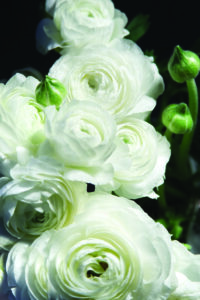
Ranunculus love the sun, but the delicate petals don’t necessarily enjoy scorching heat, so they are contenders for moveable container gardens as well.
Ranunculus surely doesn’t roll off the tongue like “rose” or “daisy,” and might not be the first flower people can identify, but to gardeners and florists, they are a household name.
Chances are, even if you aren’t sure what one looks like, you’ve seen them in breathtaking bridal bouquets and centerpieces.
Their name is Latin for “little frog.” Thoughts behind the offbeat name are that the flower originated in Southwestern Asia and grew along streams where little frogs would be.
While roses are used to show love and daisies for joy and innocence, ranunculus represent admiration.
Consider them for Mother’s Day, teacher gifts or any time you want to send someone a compliment.
The ranunculus genus has more than 600 varieties, the florist variety being Ranunculus Asiaticus.
Also known as “Persian buttercups,” these lush varieties have between 100 and 130 petals which would make for quite the prolonged game of “He Loves Me, He Loves Me Not.”
No matter what color you’re going for, there’s a bloom for you. From sweet pastel and sorbet colors to a rainbow of vibrant brights, there’s every hue in between.
Aside from the florist stunners, it should be mentioned that the ranunculus family also includes a flower that everyone is very much familiar with.
Heck, you might even be growing it now. Buttercups! Also referred to as crowfoot, buttercups certainly are the plain cousin of family but their cheery yellow is beloved just the same.
Fun to pick even without dense layers of petals, they pop up along woods and in pastures.
As for the more intentionally sown florist varieties, they are grown most commonly by corm. You may hear of folks starting by seed as well, but corms generally make for easier success.
Corms are best tucked into a sunny spot in your garden in the fall, but you can definitely give them a go by pre-sprouting them in the spring and trying your luck then.
Give them a soak for about four hours and then plant in some trays in a warmer area of your house until they start to peek out of the top of the soil.
Bigger corms lead to bigger flowers and blooms so take care in picking your variety.
There’s a size, color and shape for everyone and careful choosing will pay off. A single plant can have up to 35 blooms in one growing season.
Ranunculus love the sun, but the delicate petals don’t necessarily enjoy scorching heat, so they are contenders for moveable container gardens as well.
Another thing to keep in mind is that ranunculus can be poisonous to cats, dogs, horses and even humans.
So, no, they shouldn’t be where your pets frolic and for goodness sake, don’t try to float it in your mimosa.
From there, if you have success getting them to bloom and want to enjoy them in a bouquet, wait until the flower is completely squishy for the most longevity and clip closest to the base to encourage another flower to pop up.
If the middle of the bloom is still hard, leave another day or so for it to be fully ready. Beyond being aesthetically pleasing, when cut they can stay lovely for about seven days.
If you’re already successfully growing buttercups, give their glamorous cousin a try too with some florist-style ranunculus.




